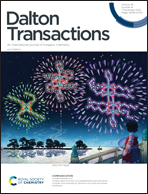Antenna triplet DFT calculations to drive the design of luminescent Ln3+ complexes†
Abstract
Density functional theory-based methods have been exploited to look into the structural, vibrational and electronic properties of antenna ligands, all of them being crucial factors for the reliable design of customized luminescent lanthanide (Ln3+) complexes. The X-ray structures, UV-Vis absorption spectra and triplet (T1) energies of three novel β-diketone ligands with a thienyl group and naphthyl (L1), phenanthryl (L2), and pyrenyl (L3) polycyclic aromatic hydrocarbons as substituents have been modelled. Vibronic progressions provide a strong contribution to the L1 and L2 absorption spectra, while the L3 absorption spectrum needs the assumption of different conformational isomers in solution. T1 energies have been estimated either through the vertical- or the adiabatic-transition approach. The comparison with the phosphorescence spectra of Gd3+ complexes allowed us to infer that the latter approach is the most suitable one, in particular when sizable ligands are involved. Results obtained for the isolated antennas can be directly compared with those of the corresponding Ln3+ complexes, due to the unanimously accepted assumption that the excitation is ligand-centred.



 Please wait while we load your content...
Please wait while we load your content...